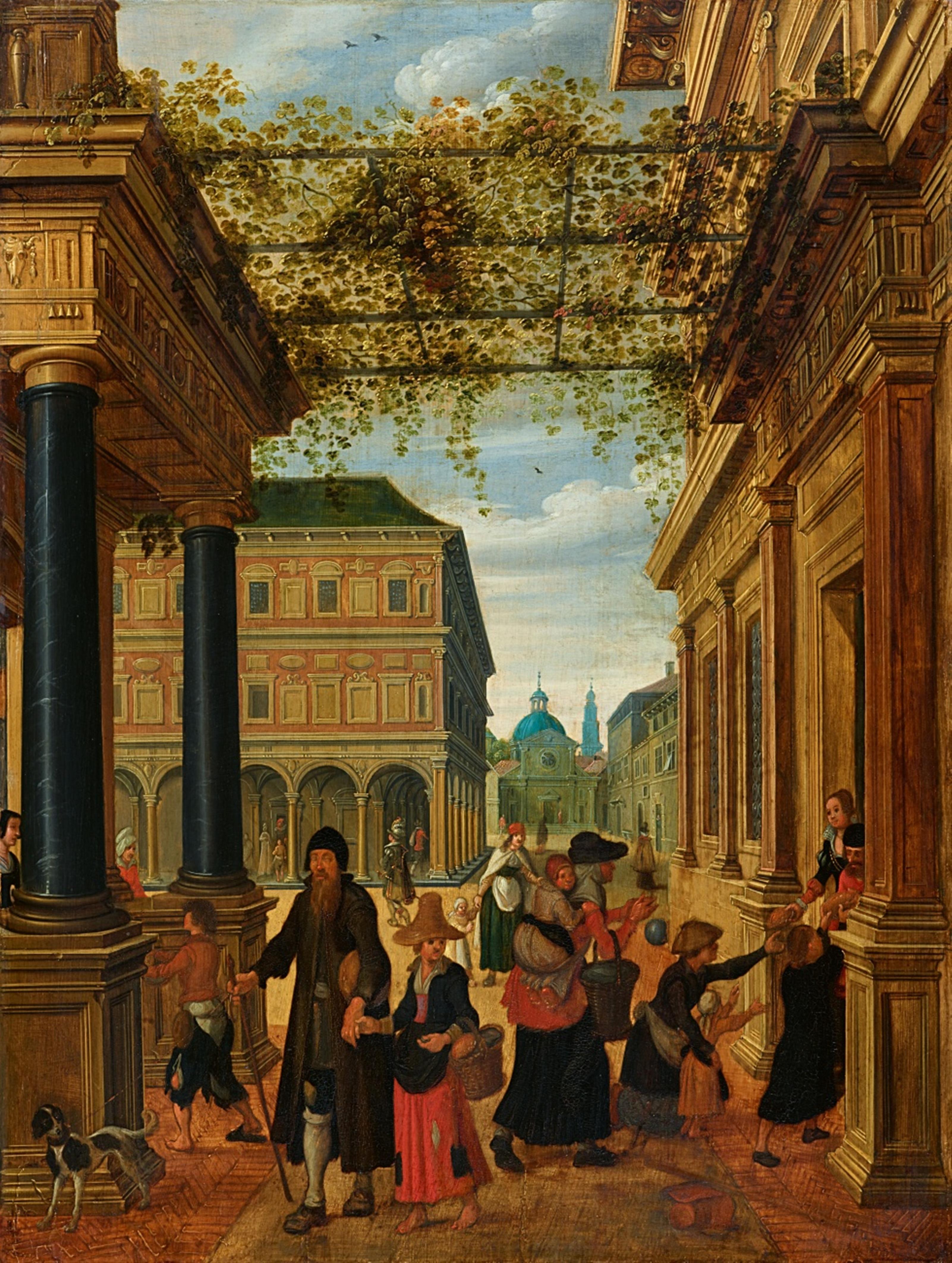Sebastiaan Vrancx
The Feeding of the Hungry
Oil on panel, mounted on another panel and parquetted. 64.5 x 48.5 cm.
The present painting illustrates the Feeding of the Hungry, the first of Seven Christian Works of Mercy. Six of these works are based on the teachings of Jesus handed down in the Gospel of St. Matthew (Mt 25:34-46), while the seventh is a supplement from the apocryphal book of Tobit (Tob. 1:17). In the foreground of this panel, several beggars are depicted as if on a stage, beginning on the left with a raggedly dressed boy between the high bases of two columns. Next to him, we see a young woman leading her blind father and finally a mother with her children being presented loaves of bread by a richly dressed couple in front of the entrance to a magnificent palace.
The scene is placed in a setting of magnificent, immaculate Renaissance architecture, which contrasts sharply with the poor figures in the foreground. Between the strongly foreshortened palace facade on the right-hand side of the picture and columns on the left, joined by a classical entablature, the view looks onto a spacious square. There, the eye is drawn to a three-storey palace with open arcades on the first floor. To one side of this central axis, our view is guided towards the background on the right, upon the facade of a domed church and a bell tower as a point de vue.
This panel belongs to a cycle of individual depictions of all the works of mercy, which Vrancx and his workshop may have executed several times and which always included a classical architectural background. Other panels of the same size can be found in the museum in Springfield, Massachusetts, and in the Stichting Nederlands Kunstbezit, among others. In contrast, a painting by Vrancx dated 1608 in the collection of the Niedersächsisches Landesmuseum in Hanover shows all seven works of mercy on one panel.
In his home town of Antwerp Sebastiaan Vrancx was a student of Adam van Noordt, who also taught Peter Paul Rubens and Jacob Jordaens. After a stay in Rome from 1596 to 1600/1, Vrancx settled again in Antwerp, where he was accepted into the Guild of St. Luke and elected Dean of the Guild in 1612. In addition, he held numerous other offices with the rifle guilds, rhetoric societies, etc., which made him an important figure in Antwerp's artistic and social life.
Vrancx was one of the first artists to specialise in depicting raids, battles and cavalry fights, and he is regarded as one of the pioneers of these genres in the southern Netherlands. He also painted views of garden parties and elegant company, as well as landscape paintings. At the same time, the extremely versatile artist was appreciated as a figure painter and added figures to works by Jan Brueghel the Elder and Joos de Momper, among others. Karel van Mander praised Vrancx, who was only 31 years old at the time, in his Het schilder-boeck, published in 1604, especially for his depictions of landscapes, horses and figures ("eer aerdigh in Landtschap, Peerdekens, en beeldekens").
Certificate
The auction catalogue of Sotheby-Maak van Way, Amsterdam 1977, mentions a now lost copy of an expertise by Dr Eduard Plietzsch from 1947 and an expertise by Dr Walther Bernt from 1963.
Provenance
With Julius Böhler, Munich;
Dr Lutz, Berlin;
Dr Hans Wetzlar, Amsterdam;
His deceased sale, Sotheby-Mak van Waay, Amsterdam, 9 June 1977, lot 69.
Literature
Friedrich Winkler: Der unbekannte Sebastian Vrancx, in: Pantheon, XXII (1964), pp. 322-34, reproduced;
Suyin Scheid, in: Ekkehard Mai (ed.): Das Kabinett des Sammlers, Cologne 1993, pp. 264 -266, no. 104, reproduced.
Exhibitions
Keuze uit de verzameling Dr. H. A. Wetzlar, Laren, Singer Museum, 14 December 1968-26 January 1969, no. 32 (reproduced in the catalogue plate 7).

